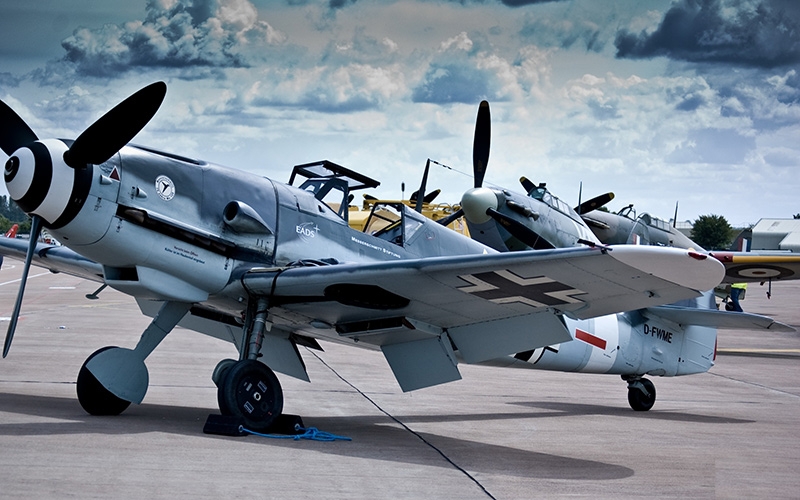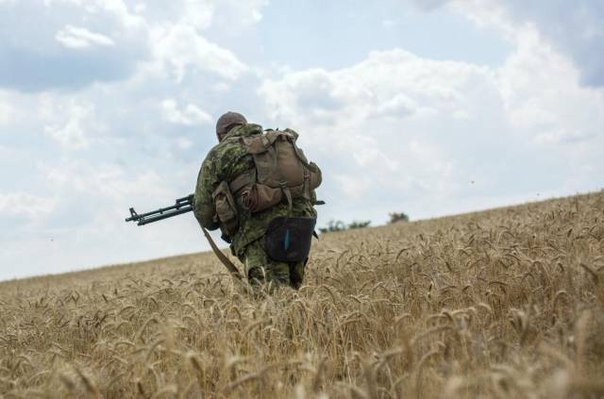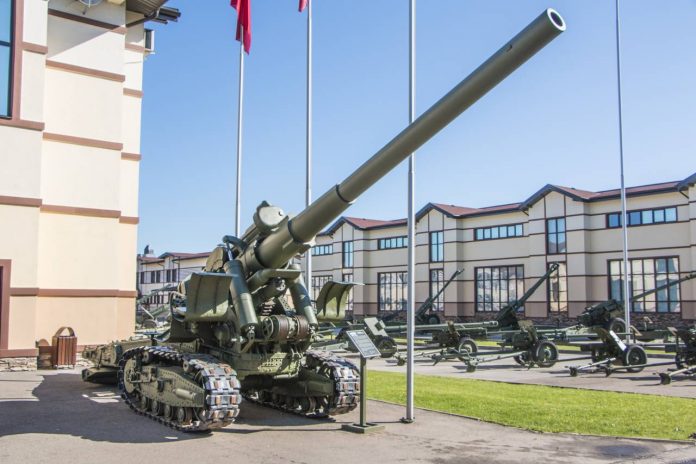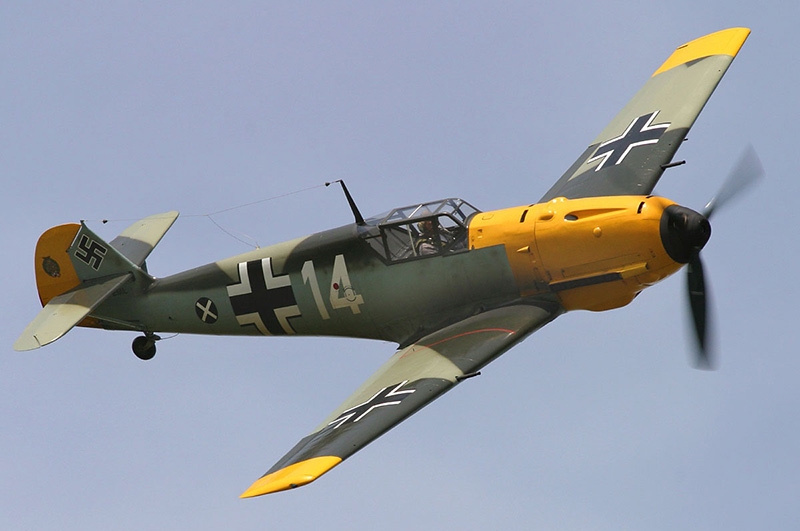
Messershmitt Bf.109 (it. Messerschmitt Bf.109, traditional for Soviet writing - ME-109) - a single-engine piston fighter nizkoplan, various countries was held at the Air Force and the Luftwaffe almost 30 years.
Messershmitt Bf 109 (I-109) – video
Depending on the modification was used as a fluorescent fighter (including specialized versions for low-altitude and high-altitude fighter versions of the family), day and night interceptor, fighter-attack aircraft, fighter-bomber, fighter fotorazvedchika fotorazvedchika and without weapons (including high-rise), as well as the training fighter. He was one of the two main fighters "Luftwaffe", the most widespread aircraft in Germany throughout World War II, as well as the most massive in the history of fighter.
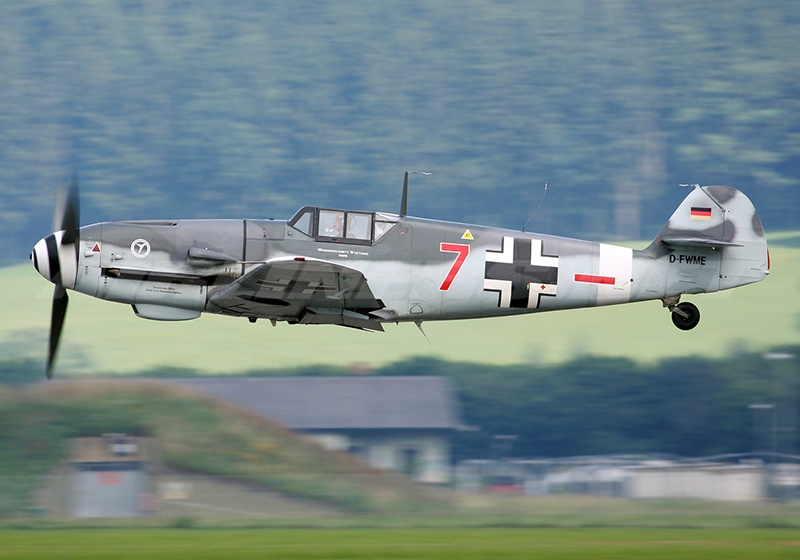
By the number of produced cars (as of 14 April 1945 year in Germany alone - 30 573 pieces - including spare parts samolotokomplekty, is about 1/6 credited as produced aircraft; total production - considering the issue in Franco's Spain in the years 1944-1958 and postwar Czechoslovakia in the years 1945-1948 - exceed 33 000 copies; There is also information, that the total production of a family of planes made Bf.109 34 826 or even 34 852 instance) It is one of the most popular aircraft in the history of, yielding only the Il-2 (36 163 cars) and the aircraft to easy general purpose Cessna 172 Skyhawk. Sometimes you can find the statement, that the training plane, and later - including a night bomber U-2 (In 2), also superior in terms of volume of production Bf.109 (called numbers to 40 thousand. issued by the U-2). But it is not supported by Soviet sources, evaluating the production of U-2 in approximately 33 000 machines.
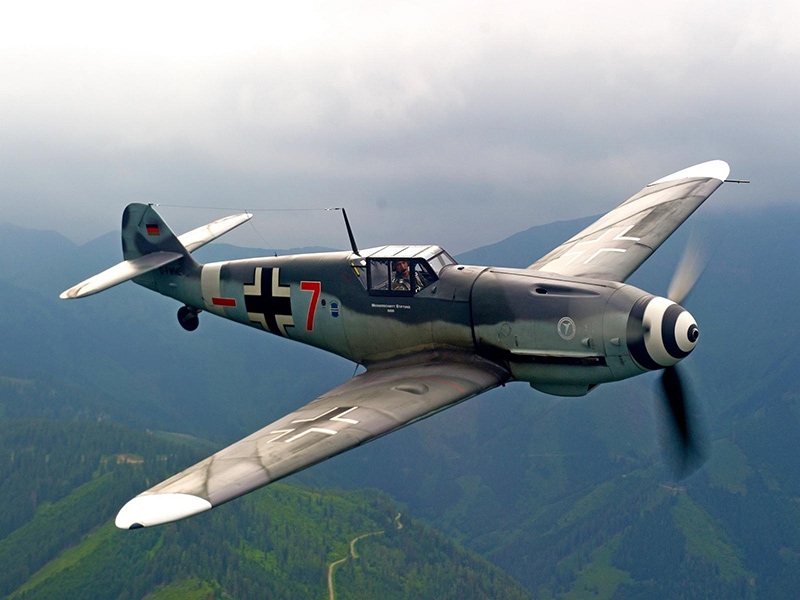
History of creation
30 January 1933 the leader of the Nazi Party, Adolf Hitler was appointed chancellor of the Weimar Republic. One of the most important tasks of the new government is to eliminate restrictions in the field of armaments, imposed on Germany by the Versailles agreements, and the creation of full-fledged armed forces. In May 1933 Year created Reyhsministerstvo Aviation, headed by Hermann Goering, Luftwaffe - to which the organization of the Air Force was assigned to.
At the beginning 1934 year technical management (T-AMT) Reyhsministerstva aircraft developed technical requirements for a modern single-seat fighter monoplane, which was supposed to replace the biplanes Henkel He-51 and Arado Ar 68. These characteristics, together with the order of experimental machines were aimed at leading firms aviakonstruktorskie - Heinkel, Focke-Wulf и Arado Flugzeugwerke. Willy Messerschmitt was denied a contract to develop on the basis of, his firm (Bayerische Flugzeugwerke, (Bf.)) I had no experience in creating high-speed combat aircraft. The technical department formed an opinion, that if the Messerschmitt fighter and will be able to create, the latter will not be competitive aircrafts more experienced designers Walter Rethel and Ernst Heinkel. The head of the secretariat of aviation Erhard Milch Affairs fully shares this view. He believed even, that, if successful Messerschmitt he still refuses to "Bayerische Flyugtsoygverke" (Bf.) in placing an order for the production.
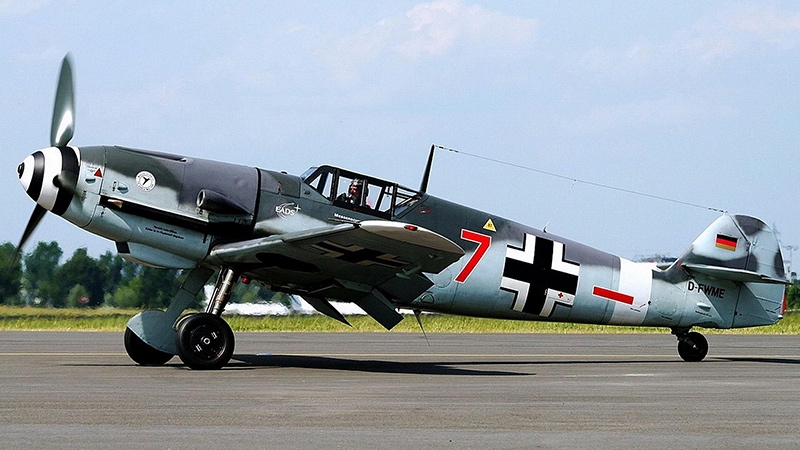
Hostility between Willy Messerschmitt and Erhard Milch stretched more with 1929 year and even more intensified with a break Lufthansa contract for ten transport aircraft, are already on the assembly in Augsburg. Messerschmitt considered illegal contract gap, and BFV, due to inability to recover the advance Lufthansa, He was forced to declare bankruptcy. The war between Messerschmitt and Milch escalated. By the time of the resurrection "Bayerische Flyugtsoygverke" Milch, which he was obliged to Hitler, He was appointed chief of the secretariat of the aviation business. Since it is now often replaced Milch Hering, Head of the Secretariat quickly gained enormous power, which enabled him to limit the operation of the Messerschmitt and orders his company just licensed production.
Without receiving orders from the German Ministry of Aviation, Messerschmitt had to apply for permission to develop the aircraft in the interests of foreign states. His co-director of P. Kokotaki able to conclude a contract with the Hungarian company "ICAR" from Budapest on the development and sale of licenses for the production of several models of light aircraft. This prompted detractors accuse "Bayerische Flyugtsoygverke" neglecting the national interests. As a result of the scandal, disputes with the Gestapo and the intervention of Rudolf Hess Technical Department connected Bavarian aircraft manufacturers to develop a new fighter.
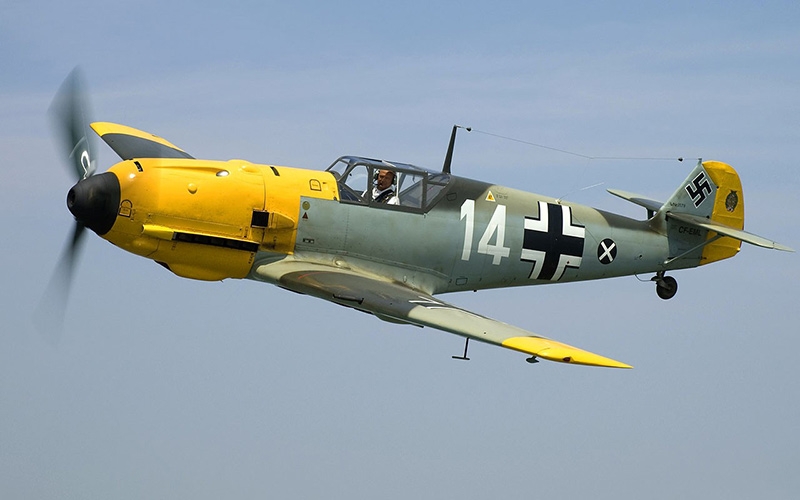
design
After getting acquainted with the technical project design team immediately began to develop new combat vehicle. Given the complex relationship with the Ministry of Aviation, Messerschmitt regarded the probability of obtaining the basic order as quite low.
Because of this, it was decided to move away from strict adherence to specifications and to work on its own initiative. Later Messerschmitt recalled, that the orientation on the terms of reference would have made a very mediocre plane.
Designed "Bayerische Flyugtsoygverke" aircraft incorporates virtually all the technical innovations of the time. The work on the project used to build a high-speed sport aircraft Messerschmitt Bf.108 Taifun company's achievements. The new fighter was an all-metal monoplane with a well-designed aerodynamics. It had retractable landing gear and an enclosed cabin. Small special wing were designed to provide high speed with the flaps. anticipated, that the aircraft will be equipped with the new engine company Junkers Jumo 210 power 610 l. from., but work on the glider moved much faster work on new engine, and to replace his British engine Rolls-Royce Kestrel VI power has been selected 695 HP.
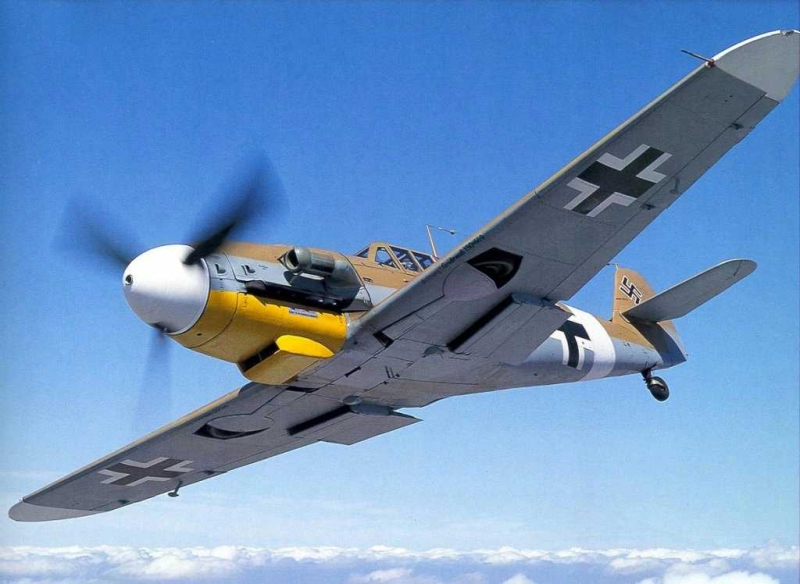
The new fighter made its first flight 28 May 1935 of the year. In accordance with the system adopted in Germany, the name he was designated Bf 109V1. In September 1935 the year the car was distilled in Rechlin on Luftwaffe ground for comparative tests. Airlines "Arado", "Focke Wulf" and "Heinkel" also presented their prototypes - Ar 80, Fw 159, He 112. The main struggle was between the fighters' Bayerische Flyugtsoygverke "and" Heinkel ". Despite, that first the speed was 17 km / h above the speed of competitor, and it was easier to manage, Luftwaffe experts initially preferred car Heinkel. Unflattering reviews about Messerschmitt gave the famous flying ace of the First World War Ernst Udet (who later became an ardent supporter of the adoption of the aircraft into service).
The next prototype Bf 109V2, already equipped with an engine Jumo 210A, He launched a test flight in January 1936 of the year. More in two versions Bf 109V3 and Bf 109V4 were taken into account the requirements for strengthening the arms. The Heinkel fighter were also made significant changes. In March 1936 of the year, and undecided, Luftwaffe made the pre order 10 Both fighters manufacturers. In August of the same year Messerschmitt-109 was first shown to the public during the opening ceremony of the Summer Olympic Games in Berlin. At the beginning 1937 of the year, after military trials under real combat conditions, Bf.109 was adopted as the main fighter of the Luftwaffe.
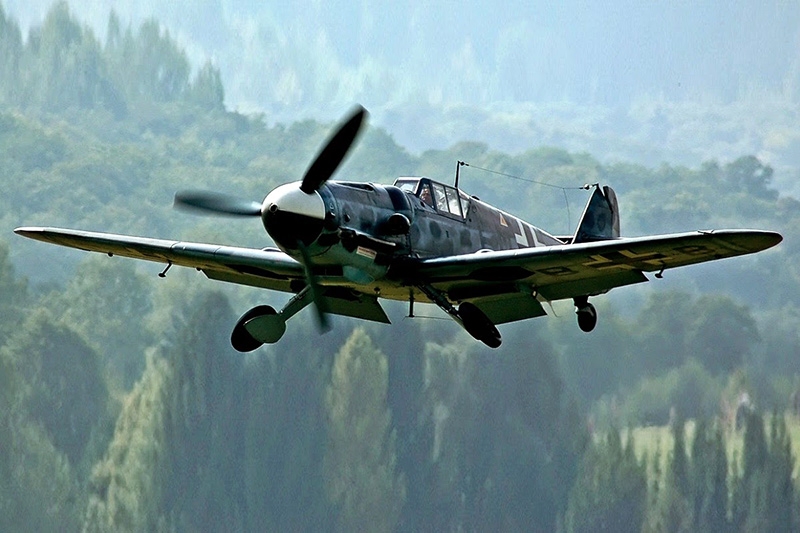
designations
Since Bf aircraft project 109 It was submitted to the aviation Reyhsministerstvo (RLM) by Bayerische Flugzeugwerke, in all official German documents in the designation of the aircraft used by the prefix «Bf».
Nevertheless, after July 1938 of the year, when the company «Bayerische Flugzeugwerke» was renamed «Messerschmitt AG», inside the company, as well as outreach publications Luftwaffe became widely used designation «Me 109". This designation, probably, mistakenly, It was applied to the factory and manufacturer's plaques. However, officially the German armed forces the prefix «Me» has never been used.
In literature, as the World War II, and in modern, used both designations, and both designations are believed to be correct, although from time to time there are disputes about it.
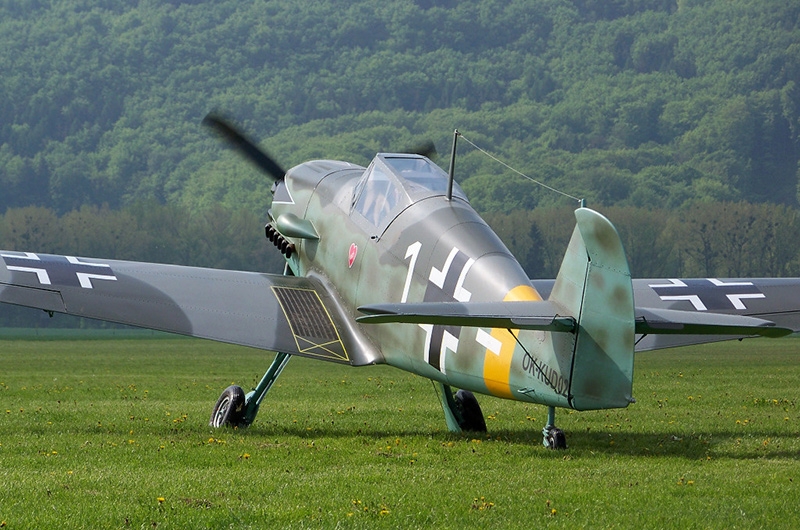
serial modification
Bf.109B
The first commercial version was named Messerschmitt Bf.109B or "Bruno" (Bruno, some sources known as Bertha). The aircraft was equipped with an engine Jumo 210 and armed with three (in later versions - four) caliber machine guns 7,92 mm. Production of this aircraft began in February 1937 year at a plant in Augsburg.
Bf.109C
At the beginning 1938 the year coming off the assembly line following the mass modification of aircraft, known as Messerschmitt Bf.109C «Caesar» (Caesar, elsewhere - Clara). It had a number of design improvements over Bf.109B and equipped with a more powerful engine Jumo 210A with a fuel injection system. Fighter had four machine guns in service: two of them are located on the engine, and one - at the base of each arm of the wing.
Bf.109D
For "Caesar" was followed by "Dora" (Dora), This name belongs Messerschmitt Bf.109D. It was supposed to equip the engine Daimler Benz 600, power 960 l. from. But due to lack of engines, which also went to He.111, on "Dora" established Jumo 210D. Armament remained the same, how and Bf.109C - 4 pulyemyota 7,92. In a small amount of armament consisted of only two machine guns.
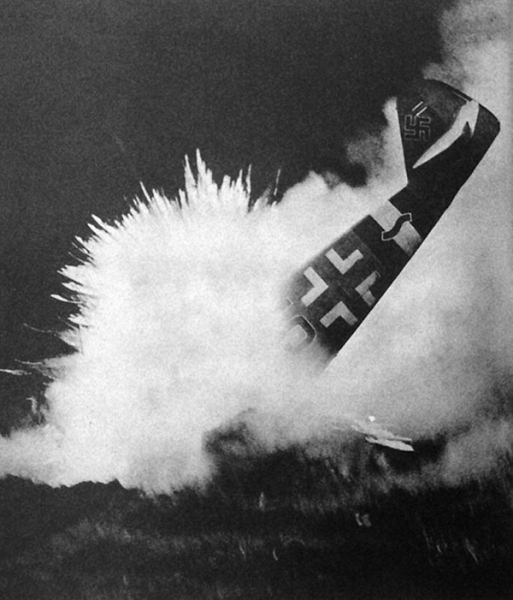
Bf.109E
Another modification was the "Emil" (Emil) - Messerschmitt Bf.109E. It was, in fact, the first truly mass model aircraft. The fighter was equipped with the new engine Daimler-Benz DB 601 with direct fuel injection system and a hydraulic clutch in the drive blower. But the most important thing was, that this engine was much more reliable its predecessor.
The first machines of the new modifications done to the troops at the beginning of 1939 of the year. Basically, "Emily" were armed with two 7.92 mm machine guns,, mounted in the housing, and two 20-mm cannon MG FF (Eng.)Russian. (it. FF = "Casement" - здесь рус. mounted in the outer wing, by 1941 it Goda MG FF / M, it. M = Minenmunition - Russian. explosive cartridges), located in the wing consoles (in a series of E2 was the only one gun, shooting through screw shaft [later, in the F-Series, because of the problems is replaced by MG 151]). Starting with the E7 series (1939) It appears on the front plane bulletproof cockpit thickness 58 mm, set at an angle 30 degrees from the vertical, and the tank located behind the 6-mm steel armored plate, all overlapping section of the fuselage.
Bf.109F
Battle of Britain revealed, that "Emile" is quite capable to fight on equal terms with the latest British fighter Spitfire Mark 1, but the emergence of new versions of the Spitfire virtually negate this advantage. In place of "Emile" come "Friedrich" (other sources call this modification "Fritz"[13]) - Messerschmitt Bf.109F. "Friedrich" began to enter the battle of the spring 1941 of the year, and by mid-year 2/3 Luftwaffe fighter units were armed with this particular machine.
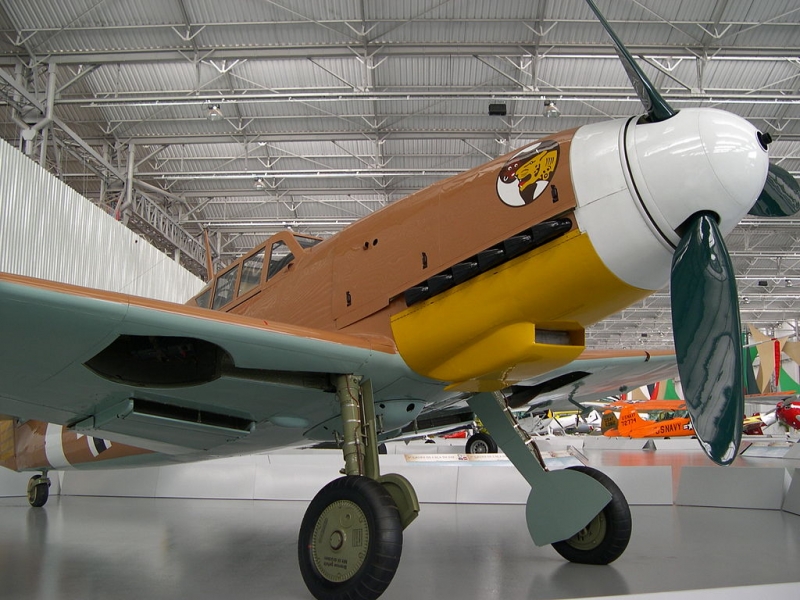
Messershmytt Bf.109 G-2
Bf.109G
The following modification, Messerschmitt Bf.109G (Gustav, "Gustav"), has become the most popular model Bf 109, had a new engine Daimler-Benz DB 605. This was, in fact, DB engine 601 a cylinder block, recycled so, that the total volume of the cylinder has increased from 33,9 to 35,7 liters, which gave more power to the 175 horsepower without any appreciable increase in the size. It was reinforced arms: instead of the standard machine guns MG 17 caliber 7,92 mm were installed 13 mm machine guns. On each side of the engine cover appeared typical projections - fairings supply system of new guns. However, additional equipment and weapons have increased the weight of the "Gustav", compared to the "Friedrich", on 10 % (In comparison with "Bruno" total weight increased 46 %). New aircraft began to enter the army in May 1942 of the year.
In fact, Me-109 reached its ceiling in technological development and, Ideally, had to give way to more modern models. But, First - To plan to replace him Messerschmitt Me.209.II was still in the development stage, and secondly - the case at the front still is in favor of Germany, and senior management decided to go on ways to further improve the machine.
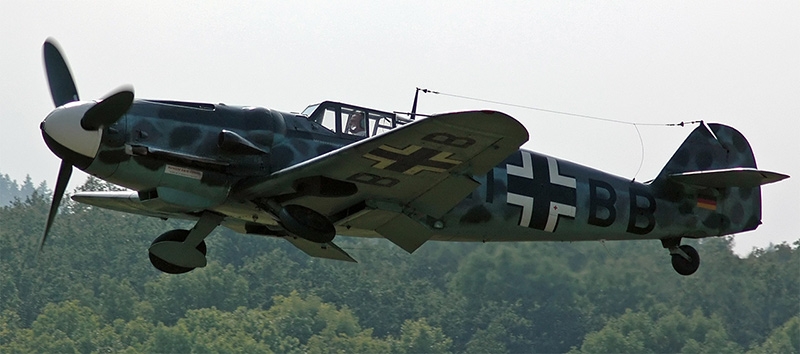
Messeršmitt-Me 109 G-6
BF109 G-6
The most massive model BF-109. Put into production in February 1943 of the year. In this version, 7.92 mm machine gun MG-17 was replaced by 13 mm machine guns MG-131. This has led to the emergence of two big blisters on the sides of the hood (had its breech guns) and speed reduction on 9 kmh. Originally designed as a universal carrier, makes it possible to quickly change the field equipment of the aircraft, depending on the environment and combat missions. Bronespinka for the pilot seat headrest had a transparent bullet proof glass, significantly improves the viewing.
There were built about 12000 aircraft G-6 (the exact number is difficult to name, since the number of factory documents do not coincide with the records of the Imperial Ministry of Aviation). There was also a version of the G-5 - the only difference from G-6 was the presence of pressurized cabin. Total May 1943 to August 1944 , it was built 475 aircraft G-5.
For high-altitude flight version of G-5 / AS was established with the engine DB 605AS. engine DB605AS, It runs on gasoline with an octane rating 96 instead of 87 it, developed in afterburner power more 2000 l. from. on high 500 m 1800 l. from. on high 5000 m. Total was made about 700 Models / AS. Planes G-5 and G-6, GM-1 system altitude afterburner received postfix «/ U2» (apparently they can be easily distinguished by the changed (aerodynamically clean) engine hood). Besides, 6-I model was equipped with engine boosting system MW 50.
In addition to these changes, 6-th model (Series / U4) at the beginning 1944 year appeared for the first time the central gun, 30 mm (MK-108). The gun was completed on tape 60 Shots with high-explosive projectile (M-basement). One projectile mass 330 g (mass burster 85 g) It was enough to destroy the single-engine all-metal fighter. On the shooting down of a twin-engine bomber takes no more than 4-5 rounds.
Besides, at 1943 year G-6 is often set the suspension for bombs or rockets, external tank, machine guns with additional nacelle. Besides, plane was used as a night fighter.
There were the following embodiments G-5 and G-6:
– G-5 (fighter with a pressurized cockpit)
– G-5 / U2 (altitude fighter with GM-1 afterburner)
– G-5/U2/R2 (altitude fighter aircraft reconnaissance afterburner with GM-1)
– G-5/AS (high-altitude fighter with the engine DB 605AS)
– G-5y (commander fighter)
– G-6 (lightweight fighter)
– G-6/R2 (fighter-scout with MW 50)
– G-6/R3 (fighter-reconnaissance long range - with two outboard underwing fuel tanks for 300 l)
– G-6 too (fighter for use in the tropics)
– G-6 / U2 (with GM-1)
– G-6/U3 (fighter-scout)
– G-6/U4 (G-6 30 mm cannon MK108)
– G-6y (commander fighter)
– G-6/AS (high-altitude fighter with the engine DB 605AS)
– G-6/ASy (high-altitude fighter commander)
– G-6N (night-fighter, usually Rüstsatz VI (two underwing gun MG 151) and, sometimes, with radar FuG 350Z Naxos)
– G-6/U4 N (G-6N c 30 mm center gun MK 108)
Cabin Me-109
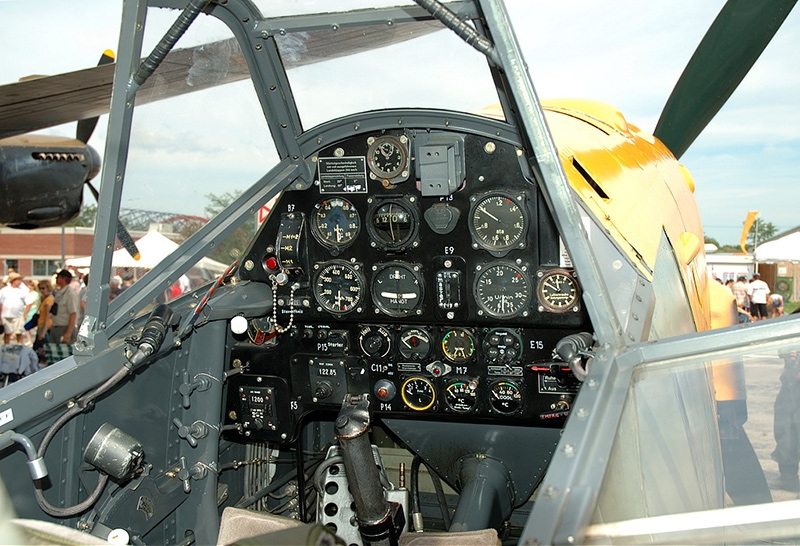
One improvement of offensive weapons in the Bf 109G 1943 year was the installation of missiles Werfer-Granate 21 - one launch tube under each wing panel. Missiles with a massive (40.8 kg) warhead stabilized in flight rotation. Aiming performed using a standard mirror sight Revi. In an emergency, the pipe could be dropped by a small explosive charge. This weapon is intended as a weapon, able to hit the target, It is outside the reach of enemy defense. rocket launcher, which had a firing range in 1200 m (outside the effective range of fire safety on-board machine guns and cannons allies), used against army allied bombers. rockets Wfr. Gr. 21, mounted on G-5, G-6 and G-14 were called informally BR 21 (Bordrakete 21 cm). In the version of G-10, the complex received the designation of weapons Rüstsatz VII.
For 1943 years many improvements appear gradually. So, to improve the pilot survey was designed transparent headrest with bullet proof glass (Galland Panzer). Replacement opaque armor plates on the new transparent head restraint was launched in autumn 1943 of the year. By the end of the year and there were lights improve visibility Erla Haube - named after the subcontractor Erla Maschinenwerk, who was involved in both the production of new models, and upgrade older versions of the aircraft. In the post-war Western aviation books and magazines this lantern mistakenly called Galland Panzer. Over time, the Bf 109G all the old lights with a massive two-section frame were replaced with lights Erla Haube. New lamp different from the old larger transparent surface, welded frame has been reduced to a minimum, also it has been removed rear fixed part - now the entire rear part of the fold-up hinged right.
Bf 109 G-5, G-6, G-14 with the engine AS, G-10 and K-4 received the modified engine hood. Sagging, closing gilzootvody machine guns MG 131, We did streamlined, their extended and increased (now they are covered not only weapons, but also the motor mounting frame). Initially, the experimental variants was symmetrical hood. Later, for the installation of larger blowers, it was necessary to change the upper part of the engine mounting and frame, as a result, The final form of the new bonnet has become asymmetrical - uvelichon hood on the left side (there, where the charger is fitted). In addition - a special streamlined panels have been developed, dockable front fuselage. There are several types of such panels. Unlike previous fairings, new panels for efficient aerodynamic shapes were barely visible in profile.
Some variants of G-6, as well as later versions of Bf 109 G had a high wooden tail and rudder modified, which gave greater stability at high speeds. Ailerons multiple production batches were equipped with servo, which reduced the impact of the control at high speeds. Besides, for guidance from the ground planes (radionavigation Y-Verfahren) installed on the aircraft radio station FuG 16ZY.
At the beginning 1944 Year Bf 109 G-6 got new engines: with large blowers to improve flight characteristics at high altitudes (DB 605AS), with water injectors for improving the characteristics at medium and low altitudes (DB 605A), with both supercharged, and the injector (DB 605ASM). Maximum speed G-5 / G-6 at the ground was 530 kmh, and 640 km / h on the estimated height 6600 m.

Bf.109K
The last production version was the "Elector" (Kurfurst) - Messerschmitt Bf.109K, supplies to the troops which began in September 1944 of the year (according to other sources - in 1945 year). The fighter was equipped with an engine Daimler Benz 605 SDM / DCM and had increased armament: Some options for up to two 30- or three 20-mm cannons. According to an article in the magazine "Wings of Motherland", one of the most experienced pre-production samples Bf-109K passed military tests on the Soviet-German front in the fall 1943 of the year. Pilot company Messerschmitt, who moreover had combat experience, I flew on it at one of the Soviet airfields and surrendered, "Grab" passing his wingman on Bf-109G. Unfortunately, at the beginning of our test pilot plane was broken, but the fact is interesting research Bf-109K almost a year before taking it to the Luftwaffe, although, of course, serial samples had some differences.
Bf.109T carrier aircraft (trager)
Based fighter Messerschmitt Bf.109T built for deployment on the German aircraft carrier "Graf Zeppelin". The model was developed on the basis of Bf.109E-7 and among the pilots was nicknamed "Theodore" or "Tony". 109T different from the land modifications reinforced fuselage structure and chassis, presence landing hook and catapult attachment points, completely redesigned wing (increased scale and area, added folding assembly, mounted deflectable plate, performs the function of the air brakes and spoilers).
In connection with the winding down of the German aircraft carrier program in the early 1941 , the fighters began to be used with the coastal airfields with short runways (squadron JG Drontheim, JG Helgoland). The last aircraft was written off in December 1944 year due to their physical deterioration.
Fighters Bf.109T produced in the following embodiments:
– T-0 - experienced a series of 10 machines, A converted from aircraft Series E-1 (according to other sources, E-3 E-7 или);
– T-1 - a series of 70 Special construction machinery with the engine Daimler Benz 601N;
– T-2 - aircraft the T-1 to dismantle the equipment to fly from the deck, but saved the wing.
– tropical modification. For combat in North Africa used airplanes with a distinctive air intake filter. In fact, it was the serial Bf-109, with a note / Trop.
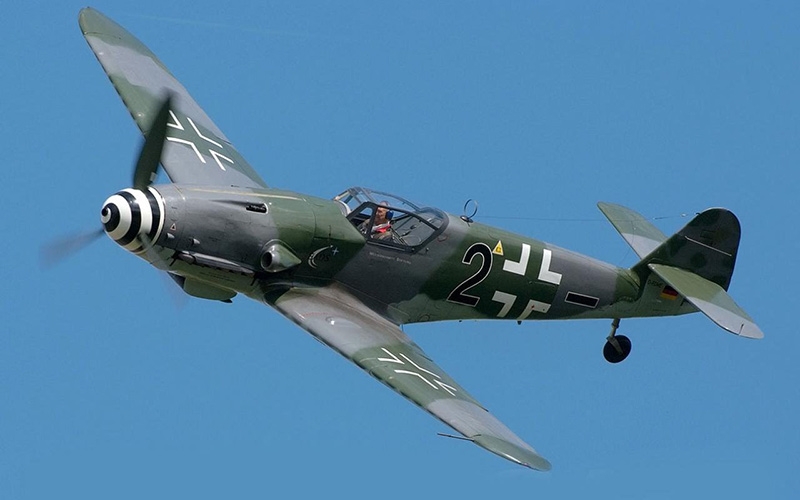
Neseriynыe modifications
Messerschmitt Bf.109A - fate Bf.109A modifications and still remains unclear - whether it did not exist, whether that letter (in writing "and") We used in relation to the first three prototypes before administration practice assignment V-proficient and head nomerov preproduction, whether the "Series A" nevertheless was released in the amount of 20 aircraft.
Messerschmitt Bf.109H - an experienced high-altitude fighter. The project was launched in 1943 year. Multiple instances Bf.109H-1 were transferred to the military tests parts of the Luftwaffe near Paris. tests revealed, that at high speed in a dive started at the aircraft wing flutter. Fine-tuning the aircraft stopped in connection with the launch of a series of Focke-Wulf Ta.152H.
Messerschmitt Bf.109X - flying laboratory for BMW-801 engine tests, designed to improve the performance characteristics of fighter aircraft. Notable wing reduced to 9,33 m span with wingtips on type Bf.109E. The first flight in September 1940 year committed Hermann Wurster. During the test, an experienced aircraft did not show any advantages over serial machines, so it was decided to keep the existing fighter production line without changes.
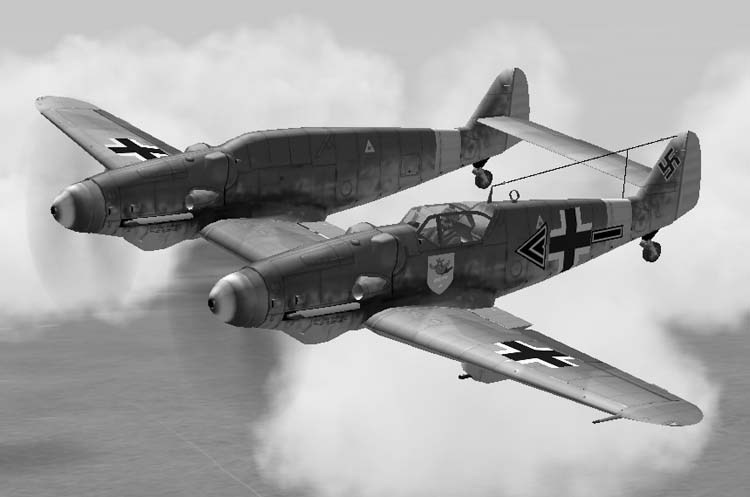
Messerschmitt Bf.109Z
Messerschmitt Bf.109Z (Z - Zwilling / double) - heavy "strategic" (further) fighter, attack aircraft and high-speed bomber. It was assembled from two fuselages Bf.109, connected with each other new central wing section and a new, united, tailplane. The pilot was in the cockpit of the left fuselage, but rather the right of the fuselage cabin was equipped with a special cone. The aircraft was planned to be manufactured in three standard (excluding aircraft "information Party" / military series Me.109Z-1) target options: Me.109Z-2 (fighter), Me.109Z-3 (Sturmovik) and Me.109Z-4 (bomber). But the only really built prototype Messerschmitt`a-Zwilling`a was destroyed by Allied air attack.
Messerschmitt Bf.109W - seaplane fighter 1939 g.
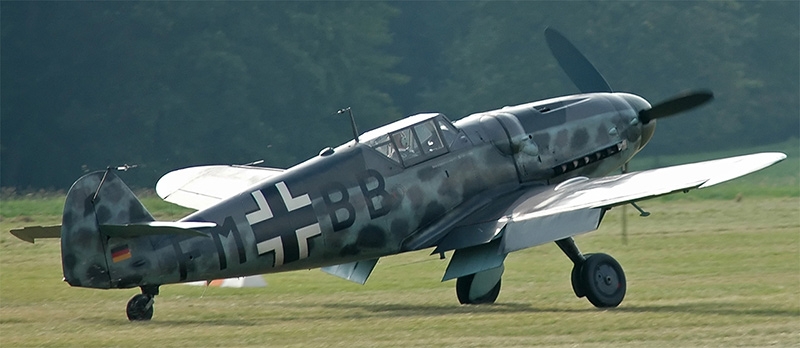
Other modifications
Messerschmitt Bf.109R. This received symbol has little in common with the plane Bf.109 Me.209 record registration at a rate (755,138 kmh, installed 26 April 1939 of the year) to FAI. Renaming was done, to create the impression of the installation to achieve on a production fighter. the aircraft itself Me.209 (first with the same name) although originally conceived as a super high-speed fighter, but actually designed and built as a purely record racing aircraft - Artisanal attempt to regain his status originally conceived war machine failed due to low maneuverability Me.209, bad review of his cabin, and a number of serious technical problems (primarily with cooling and resource powerplant).
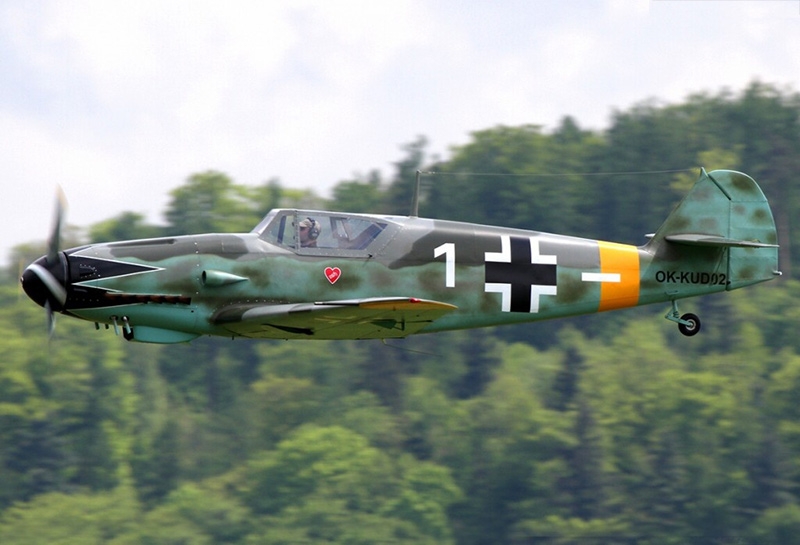
combat application
The Spanish Civil War
Baptism of fire of the new aircraft took place in Spain's sky. After the start of the Civil War in Spain, Germany dispatched a group of military pilots, which was known as the Legion "Condor", and fought on the side of the Franco regime. In service of the unit while standing fighter biplanes Heinkel He.51. Almost immediately it became clear, that the Soviet fighter I-16 have a distinct advantage over the "Heinkel" and leave them virtually no chance. Then it was decided to send to Spain for military trials latest German fighters and Bf.109 He.112. Initially, in the "Condor" Legion had two "Messerschmitt" and one "Heinkel". A failed operation and the lack of vitality in the last combat Bf.109 finally determined the choice as the main fighter of the Luftwaffe. Soon, in Spain there were already four different prototype "one hundred and ninth". 8 December 1936 of the year, piloting one of them, AND. Trautloft won the first aerial victory Bf.109.
Serial Bf.109B received service in the 1st and 2nd Squadron 88th Fighter Air Group (J/88). As expected, "Messerschmitt" far superior Soviet fighter I-15 and I-16. German planes were faster in level flight, We had more combat ceiling and was much faster in a dive. However, it should be noted, that I-16 were superior to their opponents in maneuverability, especially at altitudes below 3000 m. Over the entire period of the Spanish Civil War was delivered 130 fighters Bf.109V modifications, Bf.109S and Bf.109E, have lost 40 machines. According to the pilots of the Legion "Condor", they had is gained 314 wins, the bulk of which was won in the "one hundred and ninth Messerschmitts".
One of the fighters Me-109, padded into the air battle A. AND. Gusev and made an emergency landing in the arrangement of the Republican troops, It was donated by the USSR government of the Spanish Republic.
Capture of Poland
With the onset of World War II, during an operation to capture only Poland 5 of 24 aviagrupp, armed Bf-109, We took part in the fighting on the territory of the country. The rest of the stay in Germany, in the event of entry into the war on Great Britain and France to oppose them. In the battle against Poland applied Bf.109S modification, Bf.109D and Bf.109E. Their main opponent was the PZL P.11 - the most modern Polish fighter at that time. With speed 389 km / h, he was not a serious contender even for older models "Messerschmitt". After just a few days the Polish air force virtually ceased to exist, and fighter jets were used to assault strikes on ground targets. Two weeks later, the Luftwaffe brought from Poland two air groups and moved them to the western borders. As has been lost during the short-lived campaign 67 Bf.109, mainly - from anti-aircraft fire.
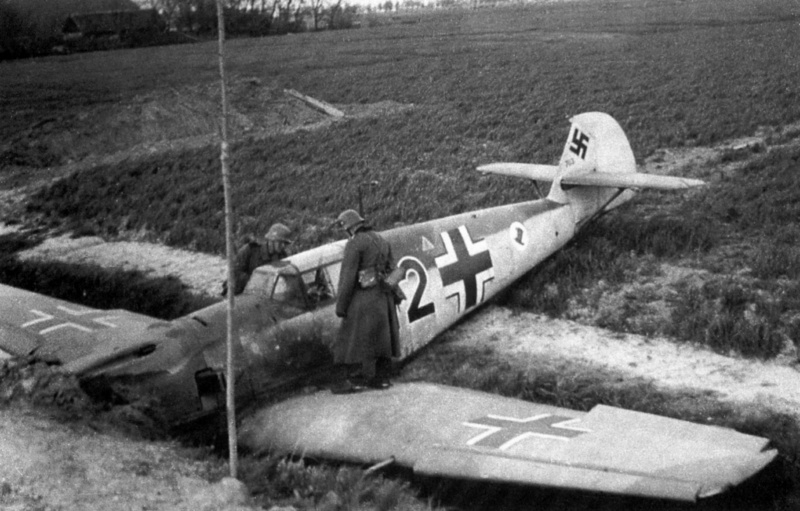
Two German soldiers inspect an emergency landing fighter Messerschmitt Bf.109 (Messerschmitt Bf.109E-3, serial number 703) from the 2.(J)/LG 2 NCO Friedrich Möller (Friedrich Möller) around Liege. The plane made an emergency landing 10 May 1940 year due to fuel production, returning from a mission. The degree of damage to the fighter of the German classification was 23%. 3 June 1940 the aircraft was evacuated to plant Earle in Leypitsige and passed reconditioning, after which he was given II./JG 51 (2-the first group of the 51st Fighter Squadron) combat missions and it performed Hauptmann Josef Foze.
Blitzkrieg in northern and western Europe
Despite, Britain and France entered the war a few days after the German aggression against Poland, fighting on the western front were not. The air along the Franco-German border were minor skirmishes fighters opposing sides. The main opponents of the "Messerschmitt" became MS.406 French and American Curtiss P-36 Hawk, standing in the French Air Force. spring 1940 year on arms began to come new types of fighters MB.152 and D.520. The false impression during the few collisions during the "phony war" at the French command, that their aircraft is not only in no way inferior Bf.109, but even surpass them in agility.
Fighter aircraft was assigned only a supporting role in the operation to seize Denmark and Norway. no more was allocated to the participation of 30 fighters Bf.109E (later it was transferred to Air Group Bf.109S fighters, increasing the group to 50 Flight). During the campaign, the pilots announced 17 aerial victories, lost ten of their cars.
10 May 1940 , the Wehrmacht launched an offensive in the west. By this time the Luftwaffe was in service 1114 Bf.109 various series, of them to participate in the campaign were allocated 860 composed of four squadrons, mixed by two fighter command. These forces opposed 550 French fighters, supported by hundreds of "Hurricane" of the British Expeditionary Force and the small number of Belgian and Dutch Air Force fighters. As a result of the first aviablow 72 Allied airfields were virtually destroyed Belgian, Dutch and a third of the French aircraft - Luftwaffe gained air superiority. In addition to the numerical superiority and experience of pilots, the role played by the advanced tactics and the technical characteristics of the German fighters. Everywhere, which appeared Bf-109, bomber and attack aircraft could strike virtually impunity, which largely contributed to the overall success of the German offensive. Serious opposition was provided only during the air battles over Dunkirk, where "Messerschmitts" opposed "Hurricanes" and "Spitfires Mk.I" RAF, operating from airfields in southern England. For the first time confronted with an equal rival power, besides its superior technically, Luftwaffe suffered significant losses and were unable to prevent the evacuation of British troops.
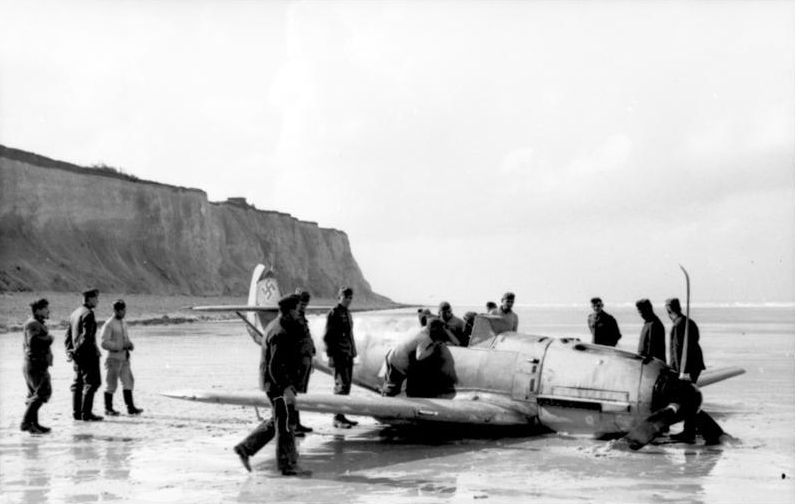
Damaged Bf-109, made an emergency landing on the French coast, summer 1940 of the year.
Battle of Britain
The Battle of Britain was the first operation, wherein Bf-109 met resistance of approximately the same number of planes, on their characteristics are not inferior to him. These aircraft were controlled pilots, prepared better than the Luftwaffe pilots. Serious factor was, that the air battles were fought over the territory of British and German fighters operated at the limit of its range - lined planes had virtually no chance to "hang on" to their airfields. For the Luftwaffe air attack has about 2800 combat vehicles, of them 760 Bf-109 fighter, mainly Bf.109E modifications. The RAF opposed them over 900 modern "Hurricanes" and "Spitfires". The undeniable advantage of defending was developed air defense network, equipped with the latest means of radar and includes more than two thousand anti-aircraft guns. In addition, through a system of "Ultra" British command has been able to concentrate their forces at the right time in the most important areas.
Aerial duel first days have shown the strengths and weaknesses of the "Emil" in comparison with their rivals. At altitudes above 6000 meters Bf-109 was slightly faster "Spitfire" in level flight and climb. At all altitudes German fighter was faster "Hurricane", which is inferior to "Messerschmitt" almost everything, except bend radius and time. At altitudes less 4600 m "Spitfire" was faster in level flight. At all altitudes, both British fighter maneuverability were "one hundred and ninth" in the horizontal plane. German fighter quickly dispersed, better he dived and surpassed his opponents (especially Hurricane) vertical maneuvers. Power-board weapons Bf-109 commands respect British pilots, whose fighters at that time armed only with machine guns caliber rifle. As a result, the German fighter firepower was 25 % above the competition, what, however, offset by a high rate of their opponents.
During the Battle of Britain, which lasted several months and dividing into several stages, role single-engine fighter aircraft has steadily increased. Unable to, during the first strikes, to destroy the British fighter aircraft, Luftwaffe to refocus their efforts on the bombing of cities, primarily London. In the changed "Messerschmitts" strategy given the role of cover formations of bombers. In these circumstances, Bf-109 limited range of action has become a determining factor. Often accompany the fighters were forced to return to their airfields before, than they could engage the enemy fighters. This dramatically reduces the effectiveness of the German single-engine fighters. Also, as it turned out, "Messerschmitt" was a mediocre fighter escort: deprived of the benefits of speed and altitude, it is poorly mastered this role. Bf.109 element was active offensive battle. In defensive battles on the horizontals of his mediocre turn and roll rate were serious flaws.
Since October 1940 of the year, failing to achieve goals, Luftwaffe switched to night bombing of England. As a result, the intensity of departures "Messerschmitt" has fallen sharply. Between the main fighting was lost 530 Bf-109.
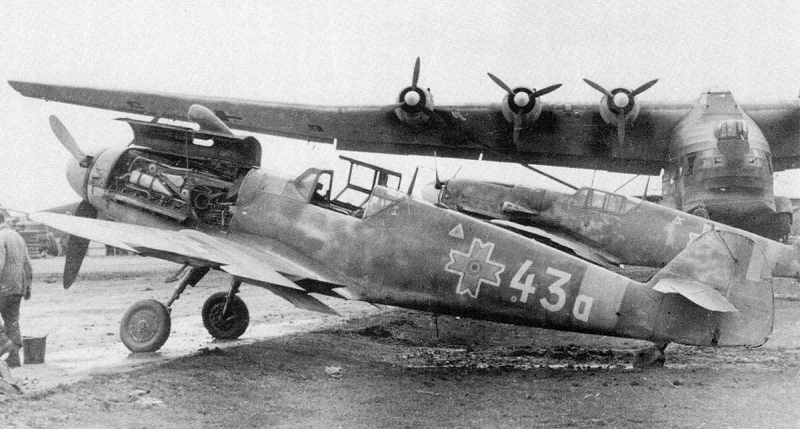
Romanian fighters of the German Messerschmitt production Bf.109G-6 and the German heavy transport aircraft Messerschmitt Me.323E-2 / WT «Giant» (Messerschmitt Me.323 «giant») at the airport. The picture is interesting by the presence on it only built transport aircraft modification Me.323 in the version of "weapons carrier" (WT - Weapons exchanger). The plane was designed for escorting transport Me.323 and different gain defensive armament (20-mm nose turret HDL 151, Four wing 20 mm turret EDL 151, four 20-mm cannon MG 151/20 in the side pivot units and four 13-mm machine gun MG 131.) The crew consisted of 17 human.
The Balkans and the Mediterranean theater of war
At the beginning 1941 year started transfer of the German air connections to the Mediterranean theater of war. first Air Group, armed Bf-109E, He appeared in Sicily in February 1941 of the year. It was later airlifted several groups, including the latest Bf-109F, to support operations in North Africa and air offensive against Malta. Even more 120 fighters have been allocated in the air group for the aggression against Yugoslavia and Greece.
During the Balkan transient Luftwaffe campaign immediately won air superiority - to confront them Yugoslav, Greek and British aircraft have been destroyed in a few days. Notably, that the composition of the Yugoslav Air Force squadron was, armed export version of the Bf-109E, took part in the defense of Belgrade. The internal opposition won by the more experienced German fighters, It had also outnumbered. In the Mediterranean, in the early stages as the situation is in favor of the Luftwaffe. Until spring 1942 , the RAF could allow the use of "Spitfires" only over its territory, while their squadron this region were mostly staffed by "Hurricane" and "tomahawks", markedly inferior "Messerschmitts" on its characteristics. Due to the qualitative superiority over the Bf-109 opponents lyutvaffe managed to hold at this theater air dominance for a long time. It has become "happy" for many German pilots, which was then won a large number of victories. So, the famous German expert Hans-Joachim Marseille are set several records. Successfully used "Messerschmitt" and as a fighter-bomber, striking against concentrations of British troops and Allied ships. 23 May 1941 of the year, Bf-109E single managed to inflict serious damage to easy the British cruiser "Fiji", who later became an easy prey for the dive bombers.
In summer 1942 years from the metropolis began mass delivery "Spitfires Mk.V» in the first squadron, based in Malta, and then in Egypt. it, along with several successful Fleet operations, dramatically changed the balance of forces in favor of British troops. Because of supply problems and strokes Communications Aviation Activity, supporting actions of the Wehrmacht in Africa, plummeted. By October 1942 , the British aviation, in no way inferior to the enemy in an aircraft, twice surpassed them in numbers. The Luftwaffe lost air superiority, and a small amount of "Messerschmitt" could not withstand the numerous "Spitfires". Having lost in the past month several leading aces, including J. Marseille, fighter air group were relocated from Africa. With the Allied landings in North Africa, the strategic situation for the troops of the Axis became simply catastrophic. To top 1943 , they were clamped on both sides of the narrow bridgehead in Tunisia. Allied air superiority was absolute, and the characteristics of their newest fighters - "Spitfires Mk.VIII», "Lightnings" and "mustangs" surpassed outdated "Emily" and "Friedrich".
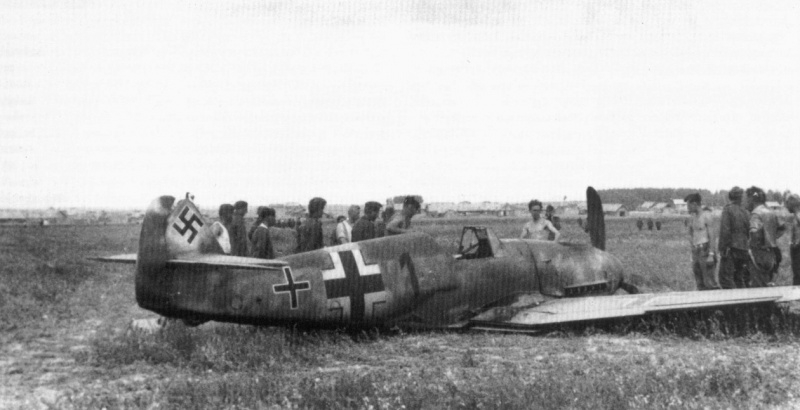
German soldiers have made an emergency landing fighter Messerschmitt Bf.109 (Messerschmitt Bf.109F-2, factory number 8945) из состава 11.Staffel / IV.Gruppe / Jagdgeschwader 51 Sergeant Major Henry Kloppera (Heinrich Klöpper) on the field in the Smolensk region.
In these circumstances, the Luftwaffe command tried to turn the tide. By transfer to the station air groups from other fronts and areas in the Mediterranean large part produced from the production of fighter aircraft fighter managed to create a grouping of over 200 machines (preferably newest Bf-109G). For several months, the German fighters successfully (given their small number in comparison with the forces opposing them) provides intensive support of ground forces at all stages of the fighting. In addition to the tasks to provide cover for ground forces, "Messerschmitts" had to perform not their inherent functions to provide cover for air and sea convoys. Here again confirmed, that "one hundred and ninth" not suitable as fighter escorts - they cover your loss of transport aircraft were simply disastrous.
After the defeat of the army group "Africa" in Tunisia, the main purpose of the Luftwaffe was the avoidance of a possible landing of the Allies on the continent. Fighter units managed to avoid defeat, carry out the evacuation of Sicily. And part of the staff has been taken in the fuselage «Bf-109" on the eve of the surrender. Mediterranean received by the Luftwaffe priority to replenish supplies and personnel. The first priority was the creation of a powerful group of fighter aircraft, able to restore control of the air. In the period from May to July 1943 the share of single-engine fighters, directed to the theater of war, It was over 40 % of the total issuance of these types of aircraft, Furthermore, two additional air group were transferred, responsible for the direct defense of the Reich. However, the superiority of the allies was undeniable - the British and American air forces blocked the German and Italian airfields on the island, subjecting them to constant air strikes. Overstretched fighter units «Bf-109" took part in defensive battles and during several weeks have been almost wiped out. Further, after the Allied landings in Sicily, during the subsequent Italian campaign (1943—1945), German fighters occasionally used in small amounts and impact on the course of hostilities had.
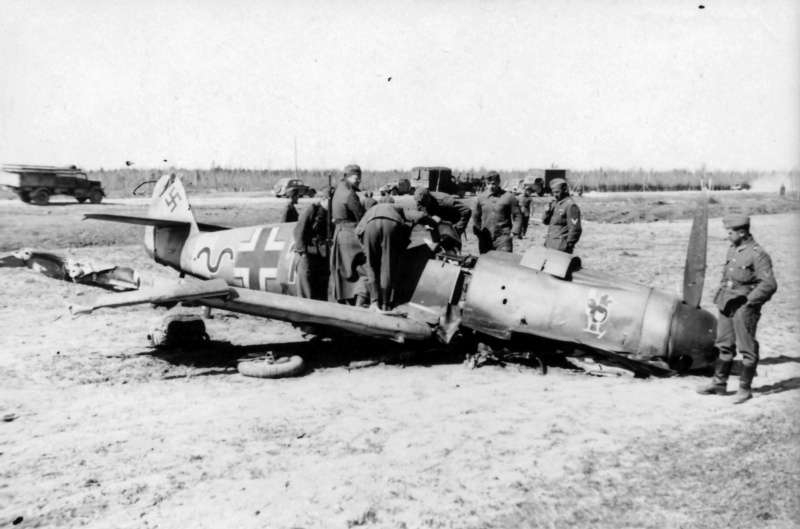
Wehrmacht soldiers inspect the downed fighter Messerschmitt Bf-109F-4 (Messerschmitt Bf-109F-4, «schwarz 13», factory number 13116 NCO Alfred Dettke (Alfred Dettke)) 54-th Fighter Squadron (8./III Group / JG 54) in a field near Chudovo. The aircraft was shot down by anti-aircraft fire 28 April 1943 year and made an emergency landing. The degree of damage to the aircraft according to the classification of the Luftwaffe was 90%.
Eastern front
By June 1941 the year in preparation for "Operation Barbarossa" on the Soviet-German border was centered over one thousand fighters "the Bf-109", of them - 40 % latest modifications Bf-109F. After a successful first 'Friedrich' pin of the air provided, taking part in air battles, whereas Bf.109E increasingly used as fighter-bombers. During the first phase of the fighting on the Eastern Front in 1941-1942 "Messerschmitt" demonstrated a clear superiority over the main types of Soviet fighters, in particular - over the outdated I-15 and I-153, as well as the infamous sky in Spain-16. Modern aerodynamic configuration Bf-109, powerful combination of engine cooling water and the high specific loads on the wing gave German fighter combat plurality likely to achieve a winning with light, manjovrennыmi, but aerodynamically less sophisticated adversaries. The advantage of the horizontal velocity supplemented ability German car gain greater speed in a dive - up 700 km / h or higher (actually speed limited only design strength and manageability, drops sharply at high speeds), as well as the ability to keep up to speed in the transition to horizontal flight and in climb. His Soviet opponents were deprived of such opportunities, therefore, a favorite tactic of pilots Bf-109 in combat with I-16 biplanes and began the attack with excess, and follow-up care "slide" up. In such circumstances, the Soviet pilots did not have any chance to catch up with Bf-109, nor to impose his style of fight: in fact, they had only to defend. On the "dog dump" Contours, where Soviet planes have the distinct advantage, Bf-109 pilots simply were not going, bringing the fight to a sequence of dives, shelling targets and drifts upward with the holding position for a subsequent attack. Only a tactic, which had to count the pilots 'mules', It was a frontal attack. If they noticed going over the top with excess "Messer", then immediately tried to turn toward, Using a good horizontal maneuverability of its planes.
Since the beginning of the Great Patriotic War, Soviet Yak, LaGG, and MiG began to carry in combat with Bf-109 heavy losses. On the results of air battles Soviet technical problems affected machines, related to "nedovedennostyu" them much more "raw" designs. Serial "Yaqui", "LAGG" and "MiG" in comparison with the prototype had a greater weight, inferior in speed and rate of climb, their units and systems reliability, their build quality and finish are often unsatisfactory. Besides, at the time of the attack on the USSR, the main type of fighter of the Luftwaffe was already considered Bf-109F with a more powerful engine and improved aerodynamics. All this, combined with catastrophic results for the USSR ground operations, total loss of initiative, plight evacuated to the east of industry, and particularly - in view of the acute shortage of time and resources for training of qualified pilots, Soviet Air Force has put in a very disadvantageous position compared to the Luftwaffe. Besides, It impacted the situation with poorly trained staff. At the beginning of the war, every seventh Soviet pilot died during the first sortie. From the very beginning of the campaign in the east Bf-109 pilots have gained superiority in the air and held it in 1941-1942.
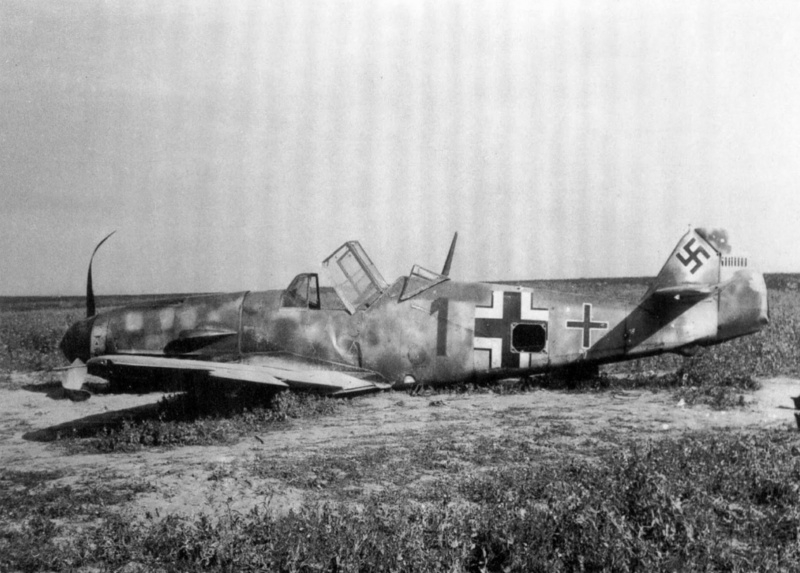
Make an emergency landing 26 July 1941 , the German Messerschmitt fighter Bf.109 (Messerschmitt Bf.109F-2, factory number 8945) из состава 11.Staffel / IV.Gruppe / Jagdgeschwader 51 Sergeant Major Henry Kloppera (Heinrich Klöpper) on the field in the Smolensk region.
Things began to change towards the end of 1942 of the year, when the Bf-109 pilots met with advanced types of Soviet fighters: La-5, Yak-7B, Yak-9, modified Yak-1, as well as set by the allies under Lend-Lease "Cobra". Their increased performance and quality of manufacture can successfully fight the Bf-109 main battle heights (due to the nature of tasks, facing the German and Soviet Aviation, dogfights in the East were, basically, at low altitudes - up 4000 m, although there are exceptions). Received a rear gunner Sturmovik IL-2 has become even more difficult and dangerous purpose - to fight with them for some time actively used trohpushechnye modification "Messerschmitt", but after a while of them had basically abandoned, because when additional suspension arms 109 Bf-characteristics fell significantly, that no longer could be ignored due to the increasing threat posed by the Soviet fighters. Usually, trohpushechnye machine piloted by only the most experienced pilots.
Kuban air battle marked the beginning of the end of the unchallenged supremacy of the Luftwaffe, followed it Kursk battle proved a turning point in the course of the air war. The era of one-sided technical and tactical superiority over Germany.
Series aircraft "Yak" to the height 4000 m fought Bf-109 on an equal footing: According to one of the leading German aces, Gerhard Barkhorn (301 victory), of all Allied fighters most dangerous opponent at low altitudes was the Yak-9. La-5, particularly - modifications "F" and "FN", He demonstrated the ability to fight on an equal footing Bf-109 to a height of 6-7 thousand meters. Nevertheless, vplot to 1945 years experienced German pilots (which, true, by the end of the war was becoming less and less) on the Bf-109 modifications «G» and «K» can successfully fight with all types of Soviet fighters, including the most advanced La 7 and Jak-3. At the same time average, and especially novice pilots Bf-109 was hard to take advantage of it, while aircraft defects (in the first place - the increased weight, said on controllability and maneuverability) We put him in a difficult position in the battle with no less speed, but more maneuverable opponents. Generally, by the middle 1944 , the Bf-109 began to give way to their main opponents on the Soviet-German front, remaining, Nevertheless, a formidable weapon, if for his helm sat experienced pilot.
Throughout the war Bf-109 was the main type of German fighter on the Soviet-German front, and carried the brunt of the air battles. Among the Soviet pilots "Messer" has earned a reputation as the most dangerous enemy air, winning the palm of the other main fighter of the Luftwaffe - Focke-Wulf FW-190, which the, with all its positive qualities, It was less suited to conduct specific to the Eastern Front fighting maneuverable aircraft at low altitudes, because of its large weight and high specific load on the wing.
Bf-109 was standing on the arms of JG52 - Luftwaffe fighter squadron, which served Hartmann, Barkxorn, Rall and other famous aces of the Eastern Front.
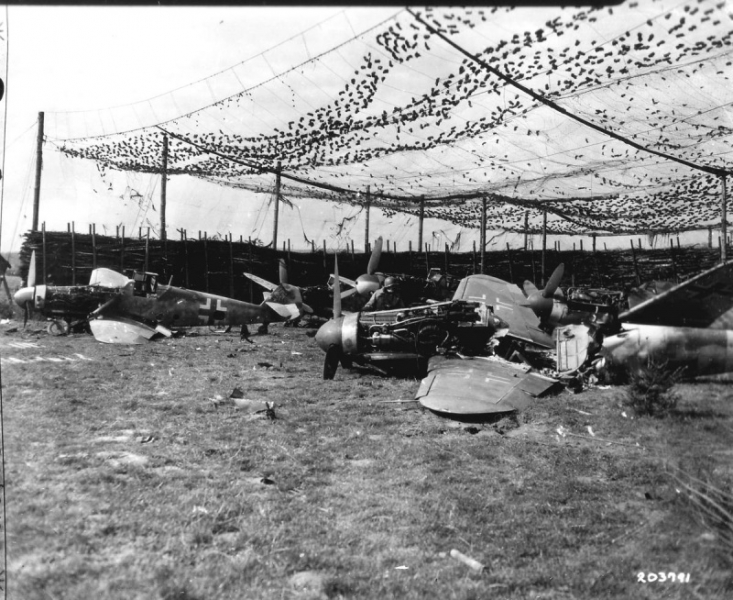
US soldier inspects the broken and abandoned German fighter Messerschmitt Bf.109 at a major German airport in Detmold (Detmold), captured 7 April 1945 year on the site the onset of the 19th Corps of the American 9th Army.
German defense
Since the mid 1942 Year of Luftwaffe increasingly had to deal with heavy bombers allies, following, as the B-17 "Flying Fortress" and B-24 "Liberator". On average, it was necessary about 20 direct hits 20-mm shells, to bring down these huge machines. While in battle formation, and subjected to attacks by German fighters, heavy bombers were the crossfire of such power, that German pilots had to attack them at high speeds, which drastically reduces the efficiency of Bf-109. Besides, the emergence of a combat theater of the latest aircrafts allies, such, as the American P-51 "Mustang", British Spitfires Mark V and Mark IX, Soviet La-5FN and La-7, which has in no way inferior to Bf-109, and the use of additional fuel tanks were able to conduct air combat almost anywhere in Germany, It resulted in a dramatic increase in losses. Trying to fix the situation, German aviation industry sharply increased the production of Bf-109. During 1943 had been issued more than 6400 "Gustavian", which is more than two times higher than in 1942 of the year. A record for the Bf-109 began in September 1944 of the year, when it was built 1605 new machines. All in all, this year was made 14212 Messerschmitt-109.
To summer 1944 , the Bf-109 G-6 could no longer compete with the Allied fighters. However, at that time the Luftwaffe has a large number of these aircraft, like new, and recovered downed. Some fighters were equipped with engines DB-605AS (Bf-109 G-6AS). Most of these aircraft were transferred to the fighter squadron home defense to intercept American bombers and fighter escorts.
Despite, that the technical capabilities of the aircraft had been nearly exhausted, German designers were trying to squeeze out of the Bf-109 everything possible, creating a highly specialized modifications. So, eg, Model G-10 was built specifically for combat with enemy fighters at high altitude. This model is equipped with Daimler Benz 605D engine with a more powerful supercharger, and his arms were somewhat relaxed. The main objective of squadrons, armed with this airplane was, It was to impose a fight fighter escort at high altitude in order, to others, better armed fighters PVO (but heavier and as a result are not able to fight with enemy fighters), such, how Fw-190A-8, could attack Allied bombers.
At that time, the quality of training of the Luftwaffe pilots greatly reduced, and very often, in intercepting Allied bombers, Bf-109 pilots could not even protect themselves against more experienced and aggressive Americans, as a result of leaving without protection followed by Focke-Wulf, not giving the chance to deal with the enemy bombers.
In the autumn 1944 year old allied campaign to destroy the German plants, producing a synthetic fuel produced results, Luftwaffe began to receive less 40 % the required fuel. Interceptions bombers occurred less and less, winter fuel shortage added to the weather conditions, in which the inexperienced pilots could not fly.
Even if the Bf-109 G-6AS and G-10 appeared six months earlier, when the Luftwaffe still had many experienced pilots, which could use the improved high-altitude performance of the aircraft, it could no longer change the outcome of the war.
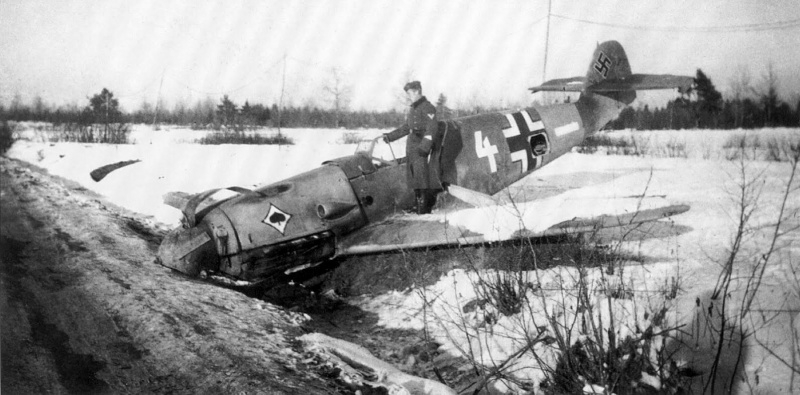
Downed fighter Messerschmitt Bf. 109F-4 (Messerschmitt Bf.109F-4, "White 4», factory number 7187) 53-Squadron Luftwaffe (4.Season / JG 53 «Pik As» - «Ace of spades") Warrant Officer Fritz Dinger (Fritz Dinger) in the district of the Leningrad region Sologubovka. The aircraft was shot down 5 October 1941 of the year.
Performance characteristics of the Me-109G-6
The crew of the Me-109
– 1 human
The dimensions of the Me-109
– Length: 8,85
– Wingspan, m: 9,90
– Height, m: 2,50
– wing area, m2: 16,20
Throughout the Me-109
– Empty weight, kg: 2675
– Mass normal takeoff, kg: 3150
Engine ME-109
– engine's type: Daimler Benz DB 605 AM V-shaped, 12-cylinder, water cooling, direct injection
– Power, hp: 1 x 1475
The speed of the Me-109
– Maximum speed at ground, kmh: 545
– Maximum speed km / h at an altitude of 8700 m: 618
Flight range Me-109
– Practical range without tank, km: 560
– The practical range with 300 lit.. tank: 990
– Max. skoropodъemnost, m / min: 690
Practical ceiling Me-109
– 11500 m
Me-109 Armament
– 2× 13 mm machine gun MG 131, Engine mounted on top (Battle stock - 300 rounds on the barrel)
– 1× 30 mm cannon MK-108 (Battle stock - 60 shells) or 1 × 20 mm cannon MG 151/20 (Battle stock - 200 shells), firing through propeller shaft
– fighter-bomber variant was able to carry one 250 kg bomb.
Photo Messerschmitt Bf 109 (I-109)
